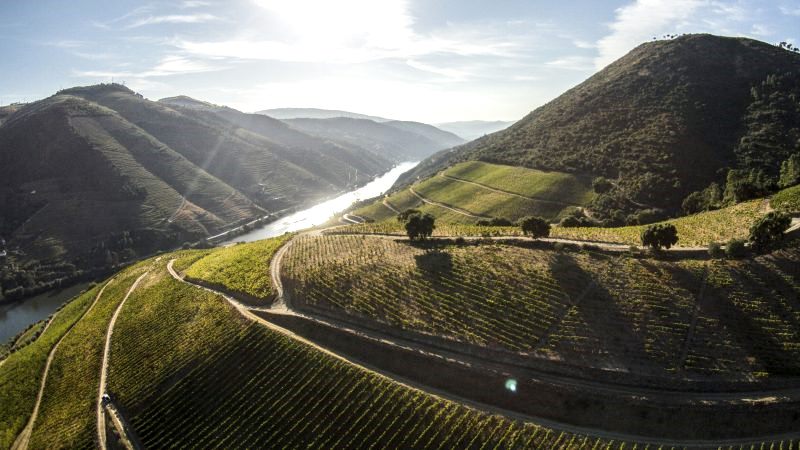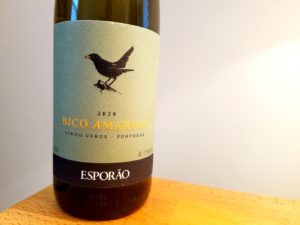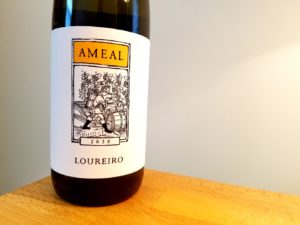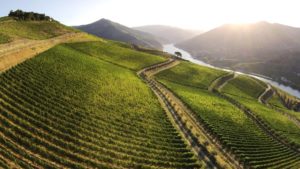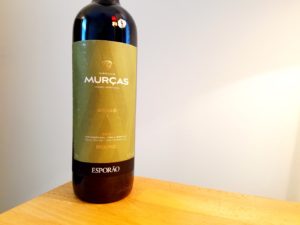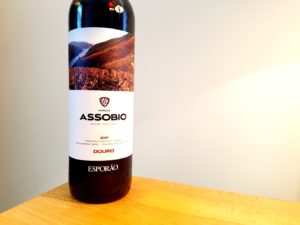Esporão’s Focus on Sustainability in Portugal’s Vinho Verde & Douro DOCs
If you appreciate Portuguese wine, you’ve probably already enjoyed a bottle from Esporão which produces over 15 million bottles a year and is one of Portugal’s top-10-largest wine producers in terms of value.
I’ve enjoyed Portuguese wines for a number of years now and recently had the opportunity to learn more about the company’s sustainability efforts in Vinho Verde and the Douro from José Luis Moreira da Silva (nickname “Zé Luis”), the Director & Lead Winemaker of Esporão’s Quinta dos Murças and Quinta do Ameal estates.
Social Sustainability
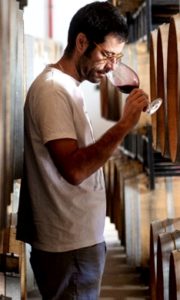
Photo Credit: Esporão. José Luis Moreira da Silva (nickname “Zé Luis”) is the Director & Lead Winemaker of Esporão’s Quinta dos Murças and Quinta do Ameal estates.
Founded in 1973, Esporão strives, “To be a family company that is economically, socially and environmentally sustainable.”
While economic and environmental sustainability may be relatively straightforward, what does social sustainability mean for Esporão — especially given the company’s large size?
Zé Luis explained, “When I say social sustainability, it means being part of a society – being part of a place.”
Many of Esporão’s vineyards are located small towns that are very poor.
Zé Luis gave the example of a small, 100-person town in the Douro Valley where 20 people are employed by Esporão.
In rural places like this the company has an outsized impact not only in the lives of its employees but also in the life of the town.
According to Esporão, one of the reasons the company has moved to organic viticulture where it can is because it’s not only better for the environment but also for its employees given long-term exposure to pesticides can cause cancer.
Currently, Esporão has over 800 hectares of certified organic vineyards.
In Vinho Verde and the Douro, Esporão focuses predominately on producing blends rather than single-varietal wines.
Blends are common in Portugal where the country has the second-largest number of indigenous grape varieties on the planet, second-only to Italy.
Many of Esporão’s wines are field blends which means rather than planting a vineyard with a single variety (e.g., Touriga Nacional, Touriga Franca) it intersperses different grape varieties within and among vineyard rows.
In the 1990s many Portuguese wineries moved to planting single-variety vineyards, however vineyards planted in this manner tend to be more susceptible to disease.
Zé Luis enjoys working with and planting field blends because vineyards with more plant diversity tend to be more resilient and also allow for the opportunity to harvest grapes with variable levels of maturity which provides balance in the resulting wines.
Vinho Verde Overview
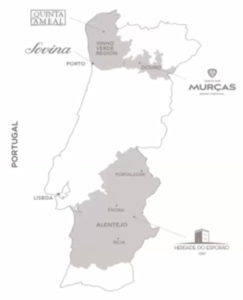
Photo Credit: Esporão.
Vinho Verde is the largest DOC in Portugal by vineyard area. It shares a border with the Douro DOC.
Vinho Verde is the largest DOC in Portugal by vineyard area.
If you live in the United States, you’ve likely enjoyed a white wine from this region as is it the number-one-selling Portuguese wine region in the U.S.
Vinho Verde is located in the northwest corner of Portugal and shares a border with the Douro DOC even as the two regions couldn’t be more different climatically and topographically.
Vinho Verde has an Atlantic climate with cool, rainy, lush green landscapes and hot, dry continental summers.
Granite and sandy loam soils predominate throughout the region.
Vinho Verde is known for producing light-to-medium-bodied white blends that are mineral driven and acid rich.
White blends tend to be composed of the following grape varieties: Loureiro, Alvarinho, Avesso, Arinto and Trajadura.
Wines from Vinho Verde are light, pleasant and food friendly and match well with the region’s cuisine which includes seafood, shrimp, cod and grilled white meats.
I especially enjoy ordering a bottle of Vinho Verde at lunchtime during the summer as the wine is low-alcohol, bright and refreshing especially in the midday sun.
Esporão in Vinho Verde
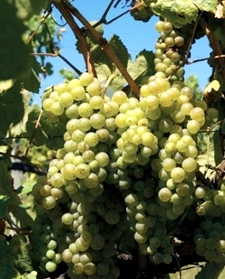
Photo Credit: Esporão. White grapes from Vinho Verde where the dominant grapes are Loureiro, Alvarinho, Avesso, Arinto and Trajadura.
Because of the disease pressure caused by the cool and rainy season, Esporão has not been able to convert its vineyards in Vinho Verde into organic certified, but it is doing experiments to bring them closer to this point.
In Vinho Verde Zé Luis concentrates on sustainable-vineyard-management best practices more than organic certification.
He thinks at least three times before making interventions in the vineyard to ensure he’s doing what’s best for the overall health of the vineyard.
Interestingly, rather than market its wine as Vinho Verde on the front label, Esporão chooses to only do so on the back label.
Labeling its wine as Vinho Verde would push the value of the wine down in Esporão’s view, and the company wants a different image for its wines.
Below are two, Esporão white wines from Vinho Verde I sampled with corresponding reviews:
-
Ameal, Loureiro 2020, Vinho Verde, Portugal (Wine Casual, 89 Points)
- Esporão, Bico Amarelo 2020, Vinho Verde, Portugal (Wine Casual, 89 Points)
Ameal Loureiro is made entirely from Loureiro which Zé Luis compares favorably to riesling.
One day he hopes to make a sparkling wine from Loureiro.
Bico Amarelo is a blend in which Loureiro adds freshness, Alvarinho adds concentration, and Avesso adds body.
Esporão prefers to whole-bunch press which imparts some tannin from the skins and adds body and florality.
Douro Overview
The Douro DOC is located in northeastern Portugal to the west of Vinho Verde.
Well-known for its Port and fortified wine production the Douro DOC, which was delineated in 1756, is the oldest demarcated wine region in the world.
Unfortified wines from the region are classified as Douro DOC.
The Douro has a continental climate with hot, dry summers.
The topography is characterized by big, steep mountains with poor soils mainly composed of schist.
The Douro is well known for producing rich, tannic reds from the following grape varieties: Touriga Nacional, Tinta Roriz, Tinta Amarela, Tinta Borroca and Sousã.
As with other areas of Portugal the Douro is known for its red blends.
Wines from the Douro pair well with cod fish, red meat, BBQ, hard cheeses and rich pasta dishes.
Esporão in the Douro
Esporão’s vineyards in the Douro are certified organic.
Rather than having horizontally-planted vineyards on terraces like most Douro vineyards, Esporão’s vineyards are vertically planted because the company feels vineyards planted in this manner yield wines with better terroir expression.
Vertical planting also allows for more uniform sun exposure and eliminates shadows from the slope or the vine itself.
Planting density is also higher in Esporão’s vineyards to create more competition between plants which results in smaller, concentrated berries.
Below are two Douro red blends I sampled from Esporão with corresponding reviews:
- Esporão, Murças Assobio Red 2017, Douro, Portugal (Wine Casual, 90 Points)
- Esporão, Quinto Dos Murças Minas 2018, Douro, Portugal (Wine Casual, 90 Points)
Esporão prefers to use indigenous yeast in its wine production process.
There has been a lot of vintage variation in the past five years with lower yields in wetter vintages.
While Zé Luis is focused on producing red blends, he would like to produce a single varietal wine in the future which he feels would be well suited to Murças vineyards.
Bordeaux’s Portuguese Future
In January of this year (2021) Bordeaux approved six new grape varieties, including two Portuguese grapes, Touriga Nacional and Alvarinho, in part due to climate change which threatens the long-term health of existing-permitted grape varieties.
When asked about the potential for Bordeaux wines to taste more like Portuguese wines in the future, Zé Luis was excited about this possibility.
However, he feels there are better grapes from Portugal that would be more suited to Bordeaux’s climate than Touriga Nacional and Alvarinho.
Because I adore Touriga Nacional and Alvarinho, I’m excited about any developments that lead to more of these two grape varieties being planted around the world.
And with climate change, it’s likely consumers will see more of these hot-weather-resistant varietals in wine shops in the future.
